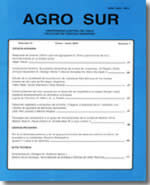VEGETACION PRATENSE LITORAL Y DINAMICA VEGETACIONAL ANTROPOGENICA EN VALDIVIA, CHILE
Main Article Content
Abstract
Coastal prairie vegetation and anthropogenic vegetational dynamic in Valdivia, Chile.
The small south central Chilean coastal plains were originally covered with Olivillo forest (Lapagerio-Aextoxiconetum punctatii) in the elevated sites and Temo-Pitra forest (Blepharocalyo-Myrceugenietum exsuccae) in the depressions. Furthermore, at the edge of the plain and in the cliff areas Patagua marina tall scrubs (Griselinio-Escallonietum rubrae) ware growing. These original vegetation has been replaced by anthropogenic prairies. Using phytosociological methods 33 vegetation relevés were lifted in the secondary anthrophogenic prairies vegetation of the Curiñanco (Valdivia, Chile) coastal plains and differentiated according to the species present in each. A total of 84 plant species were identified, of which 52 are native and 32 introduced. While the natives species are not dominant it was noted that a large number of them are present in the secondary antropogenic vegetation. In the biological spectrum the perennial weeds that dominated are indicators of anthropogenic influences and the annual weeds are those that indicate soil drought. The most important species present were: Agrostis capillaris, Anthoxanthum utriculatum, Holcus lanatus, Leontodon saxatilis and Vulpia bromoides, of which only A. utriculatum is native. In addition to these, Rubus constrictus, Juncus imbricatus, Hedyotis salzmannii, Juncus procerus and Eryngium paniculatum were also present as differential species. The following plant associations were determined: Acaeno-Agrostietum capillaris (Chépica-Cadillo prairie), Trifolio-Vulpietum bromoidis (Cepilla prairie), Junco-Agrostietum capillaris (Junquillo duro prairie), Juncetum procerii (Junquillo wet prairie), Centello-Anthoxanthetum utriculati (Paja ratonera prairie) and Eryngietum paniculati (Cardoncillo prairie). The first is formed when the Olivillo forest is cut and with the introduction of cattle. These can degrade to the second upon grazing with sheep and finally, to a third (Junquillo duro prairie), due to soil compactnees. The Junquillo prairie is formed upon cutting the Temo-Pitra forest following by gracing and these areas can degrade to a Paja ratonera prairie when rotation cropped with potato cultivars. The Cardoncillo prairie is formed in replacement of the Patagua marina scrub. The multivariate analysis confirmed the results of the traditional phytosociological ordering and established that the temperature and the soil humidity are factors that differentiate the plant associations. It is concluded that the anthropogenic activity changes the floristic composition of the prairie, increasing the diversity of the primitive vegetation.

